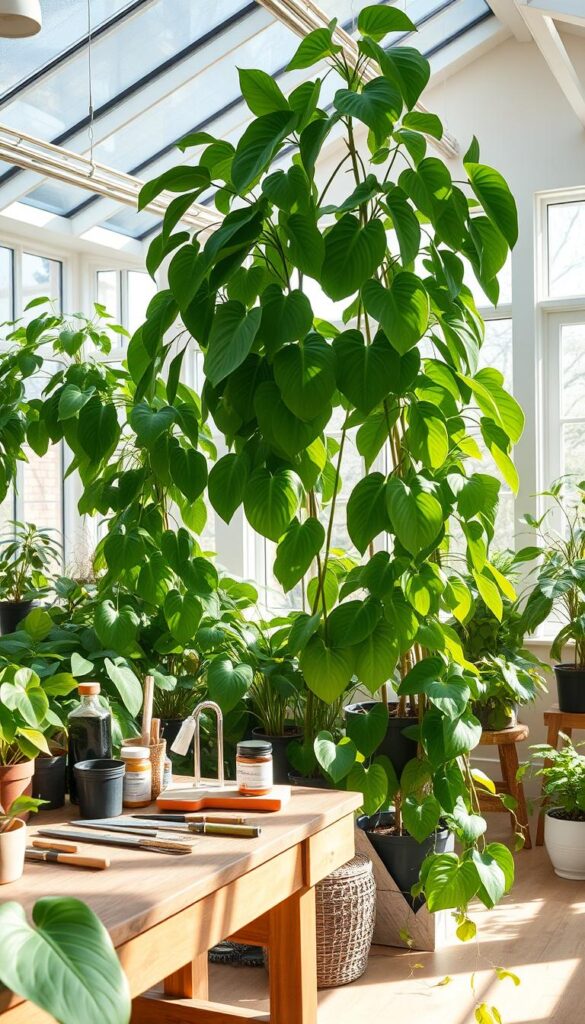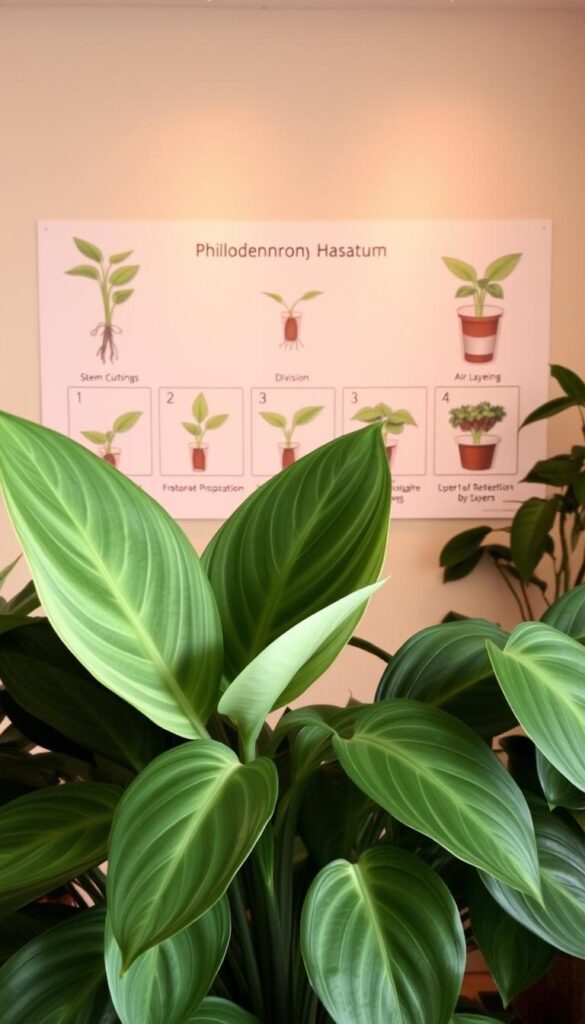I still remember the first time I laid eyes on a Silver Sword Philodendron. Its pale, silvery-green leaves, shaped like arrows, captivated me instantly. Native to the lush rainforests of South America, this plant has a way of bringing a touch of the tropics into any home. Over the years, I’ve learned how to nurture this beauty, and I’m excited to share my journey with you.
What makes the Silver Sword Philodendron truly special is its climbing nature. With the right support, like moss poles, it can grow into a stunning display. But before you bring one home, it’s important to know that its leaves can be toxic to pets and curious kids. This guide will walk you through everything you need to know, from watering and lighting to propagation and everyday care.
Whether you’re a seasoned plant parent or just starting out, this guide will give you the tools to help your Silver Sword Philodendron thrive. Let’s dive into the details and uncover the secrets to keeping this tropical gem happy and healthy.
Overview of the Silver Sword Philodendron
The Silver Sword Philodendron, also known as Philodendron hastatum, is a striking plant that captivates with its unique beauty. Native to the rainforests of South America, this tropical gem has evolved to thrive in climbing environments, making it a standout choice for indoor spaces.
Plant Origins and Unique Characteristics
Originally from the lush rainforests of South America, the Silver Sword Philodendron is known for its arrow-shaped, silvery-green leaves. As the plant matures, its leaves transform into elongated, tri-lobed forms, adding to its dramatic appearance. This philodendron’s natural habit of climbing trees makes it a perfect fit for indoor spaces, where it can be trained to grow up moss poles or other supports.
Why I Love This Tropical Climber
What draws me to this plant is its ability to bring a touch of the tropics into any room. Its climbing nature and unique foliage make it a favorite among plant enthusiasts. The texture and natural beauty of its leaves enhance any interior, creating a vibrant and inviting atmosphere.
Understanding its growth patterns and characteristics is key to appreciating this plant fully. Whether you’re a seasoned collector or a new plant parent, the Silver Sword Philodendron offers a rewarding experience with its distinctive charm and adaptability.
Creating the Ideal Growing Environment
Creating the perfect space for your plant involves balancing moisture, light, and temperature. Bright, indirect light is essential, as direct sunlight can scorch the leaves. East- or west-facing windows are ideal for providing the right amount of light without overexposure.
Humidity is another crucial factor. Mimicking the plant’s rainforest habitat, maintaining a humid environment between 50-70% is recommended. You can achieve this by placing the plant on a tray with water and pebbles or using a humidifier.
Soil should be moist but well-draining to prevent root rot. A mix of peat moss, perlite, and vermiculite works well. Watering should be consistent, but allow the top inch of soil to dry between waterings. A moisture meter can help avoid overwatering.
Monitoring root health is vital. Signs of root rot include yellowing leaves and soft stems. If detected early, repotting in fresh soil can save the plant. Regular inspection ensures your plant stays healthy and thrives.
| Condition | Recommendation |
|---|---|
| Light | Bright, indirect light |
| Humidity | 50-70% using a humidifier or water tray |
| Soil | Well-draining mix with peat moss, perlite, and vermiculite |
| Watering | Moist but not soggy; use a moisture meter |
| Root Health | Check regularly for signs of rot |

By following these tips, you’ll create an optimal environment for your plant to flourish, ensuring it remains healthy and vibrant.
Watering, Soil, and Repotting Essentials
Proper watering and soil management are crucial for the health of your plant. I always check the top inch of soil before watering to ensure it’s dry enough. This simple step helps prevent root rot, a common issue in overwatered plants.
The ideal soil mix for an aroid like this is a balanced blend of potting soil, perlite, and orchid bark. This mix ensures good drainage and aeration, promoting healthy root growth. Proper drainage holes in the pot are essential to avoid waterlogged soil.
Repotting is necessary every one to two years or when roots grow out of the drainage holes. Choose a pot that’s only slightly larger to prevent the soil from becoming too wet. Gently remove the plant, trim any rotting roots, and place it in fresh soil for continued growth.
| Aspect | Recommendation |
|---|---|
| Watering | Water when top inch of soil is dry |
| Soil Mix | Potting soil, perlite, and orchid bark |
| Drainage | Ensure pot has proper drainage holes |
| Repotting | Every 1-2 years or when roots outgrow pot |
By following these guidelines, you’ll create an optimal environment for your plant to thrive, ensuring healthy growth and vibrant leaves.
Nutrient Management and Fertilization Tips
Proper nutrient management is key to keeping your aroid thriving. During the growing season, I recommend using a balanced liquid fertilizer diluted to half-strength every 2-4 weeks. This ensures your plant gets the nutrients it needs without overloading the soil. In winter, when the plant is dormant, it’s best to pause fertilization to avoid burning the roots.
Choosing the right fertilizer is crucial. Look for a balanced formula that provides equal parts nitrogen, phosphorus, and potassium. This mix supports healthy leaf growth and overall plant development. When applying, make sure to water the plant thoroughly first to prevent root burn.
- Fertilize every 2-4 weeks during spring and summer.
- Use a balanced liquid fertilizer at half strength.
- Pause fertilization during the winter months.
Maintaining a nutrient-rich soil mix is also important. Incorporating organic matter like compost or worm castings can enhance the soil’s fertility. This creates a welcoming environment for your aroid to absorb nutrients effectively, promoting robust growth and vibrant leaves.
| Aspect | Recommendation |
|---|---|
| Fertilizer | Balanced liquid formula at half strength |
| Frequency | Every 2-4 weeks in spring and summer |
| Soil | Rich in organic matter for better nutrient uptake |
By following these tips, you’ll create a nourishing environment for your plant to flourish. Remember, a well-fed aroid is a happy one!
Propagation and Pruning Techniques
Propagating and pruning your plant can be a rewarding experience that helps it thrive. Here’s how you can do it effectively:
To propagate, take stem cuttings with at least one node. Place them in a moist environment with proper drainage. Roots should develop within a few weeks. The best time to propagate is during the active growing season, usually around the middle of the month when the plant is producing new growth.

Pruning is essential to control the plant’s shape and encourage bushier growth. Remove any damaged or overgrown areas, making clean cuts just above a node. After pruning, keep the cuttings in a moist, well-draining environment to promote root development. Look for signs of new growth, such as tiny leaves or roots, as an indication of success.
- Choose healthy stem cuttings with at least one node for propagation.
- Ensure proper moisture and drainage to support root development.
- Prune damaged or overgrown sections to maintain shape and health.
- Monitor cuttings for early signs of growth, such as new leaves.
- Place cuttings in a bright, humid spot for optimal recovery.
By following these steps, you’ll be able to propagate and prune your plant effectively, helping it grow fuller and healthier over time. Remember to look for signs of new growth and adjust the environment as needed to ensure successful propagation.
silver sword philodendron hastatum care guide
My daily routine for tending to my houseplant is quite straightforward and has been refined over time to ensure it thrives. I start each morning by checking the soil moisture, gently sticking my finger into the top inch of the soil mix to gauge if it’s time to water.
Step-by-Step Care Routines
Here’s how I keep my houseplant happy and healthy:
- Check the soil mix daily to ensure it’s not too dry or waterlogged.
- Water thoroughly once the top inch of soil feels dry, usually once a week in spring and summer.
- Feed with a balanced fertilizer at half strength every 2-4 weeks during the growing season.
- Prune any yellowing leaves or long stems to maintain shape and encourage new growth.
- Inspect for pests like spider mites or mealybugs during watering sessions.
I also make sure to repot my plant every 1-2 years, using a slightly larger pot with fresh soil mix to give the roots room to grow. This routine has proven to keep my houseplant robust and vibrant.
| Task | Frequency |
|---|---|
| Soil Check | Daily |
| Watering | Weekly (spring/summer) |
| Fertilization | Every 2-4 weeks (growing season) |
| Pruning | As needed |
| Pest Inspection | During watering |
By following these simple steps, you can create a nurturing environment for your houseplant to flourish.
Final Thoughts on Nurturing Your Silver Sword Philodendron
As you embark on nurturing your Silver Sword Philodendron, remember that consistent care is key to its success. Proper fertilization, maintaining high humidity, and timely interventions will ensure your plant flourishes year after year. The lush foliage and vibrant growth are testaments to your dedication and attention to detail.
Take time to appreciate the unique beauty of each leaf and stem. With regular checks and small adjustments in care, you can adapt to seasonal changes and nutrient needs. Trust in your ability to create an environment where your tropical climber thrives.
Embrace the journey of nurturing your plant. The effort you put into providing the right conditions will reward you with stunning foliage and robust growth. Enjoy the process, and let your Silver Sword Philodendron bring a touch of the tropics into your home.
